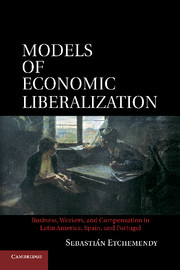 Models of Economic Liberalization
Models of Economic Liberalization Book contents
- Frontmatter
- Contents
- Acknowledgments
- Part I The Intellectual Terrain
- Part II The Political Economy of Business Adjustment
- Part III The Political Economy of Labor Adjustment
- Part IV The Market Model
- Part V Comparative Perspectives in Ibero-America
- 9 Models of Economic Liberalization in Brazil, Portugal, Peru, and Mexico
- 10 Conclusions
- Appendix
- Bibliography
- Index
9 - Models of Economic Liberalization in Brazil, Portugal, Peru, and Mexico
from Part V - Comparative Perspectives in Ibero-America
Published online by Cambridge University Press: 07 October 2011
- Frontmatter
- Contents
- Acknowledgments
- Part I The Intellectual Terrain
- Part II The Political Economy of Business Adjustment
- Part III The Political Economy of Labor Adjustment
- Part IV The Market Model
- Part V Comparative Perspectives in Ibero-America
- 9 Models of Economic Liberalization in Brazil, Portugal, Peru, and Mexico
- 10 Conclusions
- Appendix
- Bibliography
- Index
Summary
Introduction
The rest of Ibero-America appears as the ideal setting to further test the main hypotheses of this book: all the largest countries in the region share the Iberian-Catholic cultural background, all had undergone Import Substitution Industrialization (ISI) since the 1930s, all had generated private labor and business actors relatively autonomous of the state (the potential losers from market reform), and all had developed mixed (i.e., private and state-owned) industrial sectors protected by high tariff walls when the strongest international pressures for liberalization arose. This chapter extends the analytical framework to study adjustment trajectories in the other major countries of the Iberian world that underwent extensive neoliberal reform in roughly the same period: Brazil (1990–2002), Peru (1990–2000), Portugal (1985–95), and Mexico (1982–94).
As argued in the introductory chapter, the major Iberian-American countries can be essentially grouped into three models or paths to economic liberalization. The models are based on the policymaking strategies and compensatory measures (or lack of thereof) employed to make adjustment politically viable. Governments rewarded some of the “potential losers” of market liberalization: protected firms, unions and union-backed workers in the formal sector (ISI insiders), or the atomized poor in the informal sector (outsiders). Compensatory mechanisms were broadly divided into two types: subsidies, such as monetary infusions and soft credits, and market-share compensation, that is, those arrangements, such as the direct handout of state assets, the sanction of tariff regimes, barriers to entry, or the preservation of labor laws inducements, that grant market niches and serve to strengthen the role of established ISI business and labor actors in future open markets.
- Type
- Chapter
- Information
- Models of Economic LiberalizationBusiness, Workers, and Compensation in Latin America, Spain, and Portugal, pp. 257 - 299Publisher: Cambridge University PressPrint publication year: 2011


